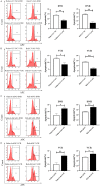Hypoxia-initiated Cysteine-rich protein 61 secretion promotes chemoresistance of acute B lymphoblastic leukemia cells
- PMID: 39113880
- PMCID: PMC11301291
- DOI: 10.62347/CKMT4065
Hypoxia-initiated Cysteine-rich protein 61 secretion promotes chemoresistance of acute B lymphoblastic leukemia cells
Abstract
The drug resistance is a major obstacle in acute B-lymphoblastic leukemia (B-ALL) treatment. Our previous study has indicated that increased levels of Cysteine-rich protein 61 (Cyr61) in the bone marrow can mitigate the chemosensitivity of B-ALL cells, though the specific source of Cyr61 in the bone marrow remains unknown. In this study, we aimed to investigate whether hypoxia can induce Cyr61 production in B-ALL cells, delineates the underlying mechanisms, and evaluates the effect of Cyr61 on the chemosensitivity of B-ALL cells under hypoxia conditions. The results indicate that hypoxia promotes Cyr61 production in B-ALL cells by activating the NF-κB pathway. Increased Cyr61 expression appears to reduce the chemosensitivity of B-ALL cell to vincristine (VCR) and daunorubicin (DNR) through autophagy under hypoxia. Notably, inhibition of Cyr61 restores the chemosensitivity of B-ALL cells to both chemotherapeutic agents. This study is the first time to report that hypoxia decreases the chemosensitivity of B-ALL cells by inducing Cyr61 production, suggesting that targeting Cyr61 or its associated pathways could potentially improve the clinical response of B-ALL patients.
Keywords: Cysteine-rich protein 61; acute B lymphoblastic leukemia; daunorubicin; hypoxia; vincristine.
AJCR Copyright © 2024.
Conflict of interest statement
None.
Figures







Similar articles
-
Chemotherapy-initiated cysteine-rich protein 61 decreases acute B-lymphoblastic leukemia chemosensitivity.J Cancer Res Clin Oncol. 2024 Mar 26;150(3):159. doi: 10.1007/s00432-024-05692-8. J Cancer Res Clin Oncol. 2024. PMID: 38530432 Free PMC article.
-
Cyr61 decreases Cytarabine chemosensitivity in acute lymphoblastic leukemia cells via NF-κB pathway activation.Int J Mol Med. 2019 Feb;43(2):1011-1020. doi: 10.3892/ijmm.2018.4018. Epub 2018 Dec 6. Int J Mol Med. 2019. PMID: 30535449
-
Cysteine-rich protein 61 regulates the chemosensitivity of chronic myeloid leukemia to imatinib mesylate through the nuclear factor kappa B/Bcl-2 pathway.Cancer Sci. 2019 Aug;110(8):2421-2430. doi: 10.1111/cas.14083. Epub 2019 Jun 18. Cancer Sci. 2019. PMID: 31145521 Free PMC article.
-
Cyr61 participates in the pathogenesis of acute lymphoblastic leukemia by enhancing cellular survival via the AKT/NF-κB signaling pathway.Sci Rep. 2016 Oct 11;6:34018. doi: 10.1038/srep34018. Sci Rep. 2016. PMID: 27725691 Free PMC article.
-
Therapeutic potential of cysteine-rich protein 61 in rheumatoid arthritis.Gene. 2016 Oct 30;592(1):179-185. doi: 10.1016/j.gene.2016.07.053. Epub 2016 Jul 25. Gene. 2016. PMID: 27457285 Review.
References
-
- Kato M, Manabe A. Treatment and biology of pediatric acute lymphoblastic leukemia. Pediatr Int. 2018;60:4–12. - PubMed
-
- Friend BD, Schiller GJ. Closing the gap: novel therapies in treating acute lymphoblastic leukemia in adolescents and young adults. Blood Rev. 2018;32:122–129. - PubMed
-
- Zhang LP, Zhang MY, Liu WJ. Mechanism of resistance and therapeutic prospect of leukemia mediated by signaling pathway in bone marrow microenvironment. Eur Rev Med Pharmacol Sci. 2019;23:6419–6428. - PubMed
-
- Benito J, Shi Y, Szymanska B, Carol H, Boehm I, Lu H, Konoplev S, Fang W, Zweidler-McKay PA, Campana D, Borthakur G, Bueso-Ramos C, Shpall E, Thomas DA, Jordan CT, Kantarjian H, Wilson WR, Lock R, Andreeff M, Konopleva M. Pronounced hypoxia in models of murine and human leukemia: high efficacy of hypoxia-activated prodrug PR-104. PLoS One. 2011;6:e23108. - PMC - PubMed
LinkOut - more resources
Full Text Sources
